中国古建筑英文
- 格式:pptx
- 大小:2.16 MB
- 文档页数:31

中国建筑英语介绍文章范文阅读中国古典建筑算是举世闻名的,如今独具特色的新建筑物也犹如雨后春笋般地出现。
今天店铺整理了介绍中国建筑的英语文章,希望大家喜欢!介绍中国建筑的英语文章篇一The Ancient Architecture中国古代建筑艺术Chinese architecture is an independent art featuring wooden structures. It consists of various roof molding, upturned eaves and wings, dougong with paintings, vermilion pillars and golden roofs, ornament gates and gardening. All of these embody the maturity and artistic appeal of Chinese architecture. 7000 years ago, mortise and tenon and tongue-and-groove were used in Hemudu. The buildings of Banpo village had the division of antechamber and back rooms. Great palaces were built in Shangyin period. Bricks and tiles were used and the layout of Siheyuan emerged in the Western Zhou. There are even building drawings in Spring and Autumn and the Warring States periods passed down.中国建筑体系是以木结构为特色阳的建筑艺术。

中国古典园林---- c lassical Chinese garden中国传统园林---- t raditional Chinese garden中国古代园林---- a ncient Chinese garden中国山水园------ C hinese mountain and water garden帝王宫苑----- imperial palace garden皇家园林----- royal garden私家园林----- private garden江南园林-------- g arden on the Yangtze Delta西方古典园林-------- western classical garden英国式园林------------- English style garden中英混合式园林--------- Anglo-Chinese style garden意大利式园林----------- Italian style garden西班牙式园林----------- Spainish style garden法兰西式园林----------- French style garden勒诺特尔式园林--------- Le Notre\'s style garden文艺复兴庄园------------- Renaissance style garden洛可可式园林--------------- Rococo style garden巴洛克式园林------------- Baroque style garden庄园---------------- manor,villa garden廊柱园-------------- peristyle garden,patio绿廊---------------- xystus迷阵---------------- maze,labyrinth灵囿---------------- Ling You Hunting Garden 周代术语灵沼--------- Ling Zhao Water Garden 周代术语灵台--------- Ling Tai Platform Garden 周代术语阿房宫------- E-Pang Palace 秦代术语上林苑---------- S hang-Lin Yuan 汉代术语未央宫---------- W ei-Yang Palace 汉代术语洛阳宫---------- L uoyang Palace 魏代术语华清宫---------- H ua-Qing Palace 唐代术语艮岳------------ G en Yue Imperial Garden 宋代术语圆明园---------- Y uan-Ming Yuan Imperial Garden颐和园------------ Yi-HE Yuan Imperial Garden承德避暑山庄-------- Chengde Imperial Summer Resort苏州园林------------ Suzhou traditional garden悬园------ Hanging Garden 又称“悬空园” ,“架高园” 。

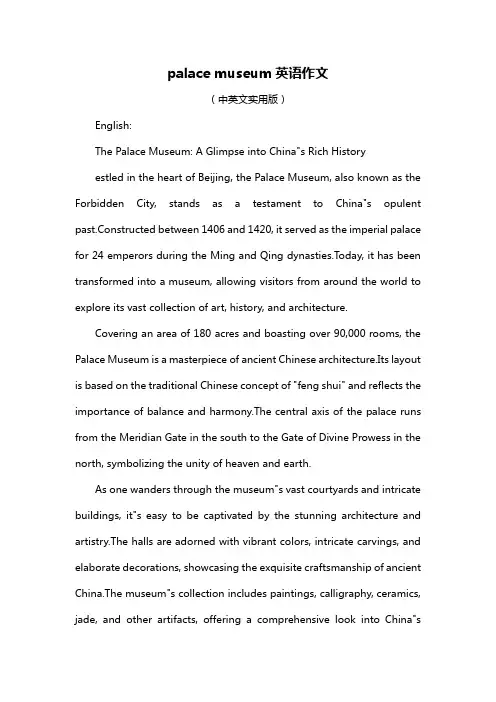
palace museum英语作文(中英文实用版)English:The Palace Museum: A Glimpse into China"s Rich Historyestled in the heart of Beijing, the Palace Museum, also known as the Forbidden City, stands as a testament to China"s opulent past.Constructed between 1406 and 1420, it served as the imperial palace for 24 emperors during the Ming and Qing dynasties.Today, it has been transformed into a museum, allowing visitors from around the world to explore its vast collection of art, history, and architecture.Covering an area of 180 acres and boasting over 90,000 rooms, the Palace Museum is a masterpiece of ancient Chinese architecture.Its layout is based on the traditional Chinese concept of "feng shui" and reflects the importance of balance and harmony.The central axis of the palace runs from the Meridian Gate in the south to the Gate of Divine Prowess in the north, symbolizing the unity of heaven and earth.As one wanders through the museum"s vast courtyards and intricate buildings, it"s easy to be captivated by the stunning architecture and artistry.The halls are adorned with vibrant colors, intricate carvings, and elaborate decorations, showcasing the exquisite craftsmanship of ancient China.The museum"s collection includes paintings, calligraphy, ceramics, jade, and other artifacts, offering a comprehensive look into China"scultural heritage.The Palace Museum also holds great historical significance.It见证了numerous important events in Chinese history, including ceremonies, weddings, and political negotiations.Walking through its ancient halls, one can almost feel the weight of history and the presence of the emperors who once ruled from this magnificent complex.In recent years, the Palace Museum has made efforts to preserve its rich heritage and improve visitor experience.Restoration projects have been undertaken to protect the ancient structures, while modern technology has been employed to provide virtual tours and interactive exhibits.The museum has also become more accessible, with multilingual guides and increased educational programs.The Palace Museum is not only a treasure trove of Chinese history and culture but also a symbol of national pride.Its grandeur and historical significance continue to captivate visitors, offering a unique glimpse into the rich tapestry of China"s past.中文:故宫博物院:窥探中国丰富的历史位于北京心脏地带的故宫博物院,又称紫禁城,是中国辉煌过去的见证。
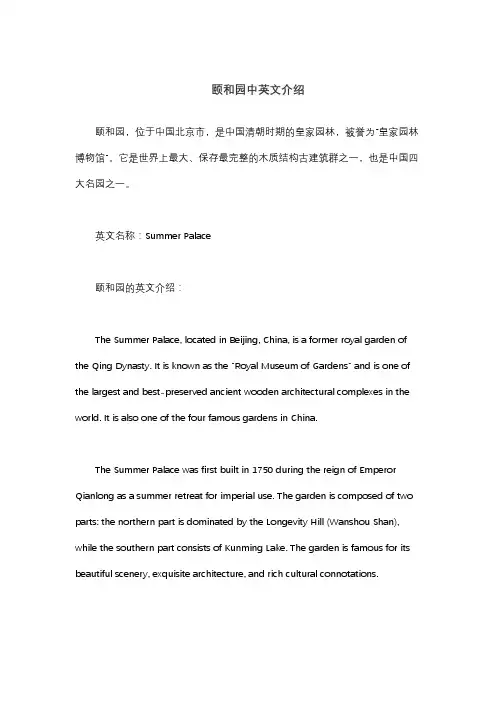
颐和园中英文介绍颐和园,位于中国北京市,是中国清朝时期的皇家园林,被誉为“皇家园林博物馆”。
它是世界上最大、保存最完整的木质结构古建筑群之一,也是中国四大名园之一。
英文名称:Summer Palace颐和园的英文介绍:The Summer Palace, located in Beijing, China, is a former royal garden of the Qing Dynasty. It is known as the "Royal Museum of Gardens" and is one of the largest and best-preserved ancient wooden architectural complexes in the world. It is also one of the four famous gardens in China.The Summer Palace was first built in 1750 during the reign of Emperor Qianlong as a summer retreat for imperial use. The garden is composed of two parts: the northern part is dominated by the Longevity Hill (Wanshou Shan), while the southern part consists of Kunming Lake. The garden is famous for its beautiful scenery, exquisite architecture, and rich cultural connotations.The main attractions in the Summer Palace include the Marble Boat, the Tower of Buddhist Incense, the Hall of Benevolence and Longevity, the Tower of Jade Billows, and the Long Corridor. In addition, the garden is home to many rare and precious cultural relics, such as calligraphy, paintings, bronzes, and ceramics.In 1998, the Summer Palace was designated as a UNESCO World Heritage Site for its outstanding cultural significance and exceptional preservation. Today, it attracts millions of visitors from all over the world every year, making it one of the most popular tourist destinations in China.。
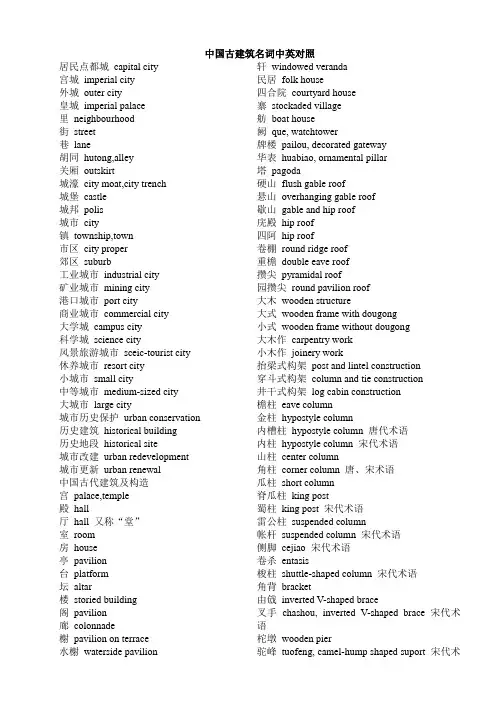
中国古建筑名词中英对照居民点都城capital city宫城imperial city外城outer city皇城imperial palace里neighbourhood街street巷lane胡同hutong,alley关厢outskirt城濠city moat,city trench城堡castle城邦polis城市city镇township,town市区city proper郊区suburb工业城市industrial city矿业城市mining city港口城市port city商业城市commercial city大学城campus city科学城science city风景旅游城市sceic-tourist city 休养城市resort city小城市small city中等城市medium-sized city大城市large city城市历史保护urban conservation 历史建筑historical building历史地段historical site城市改建urban redevelopment城市更新urban renewal中国古代建筑及构造宫palace,temple殿hall厅hall 又称“堂”室room房house亭pavilion台platform坛altar楼storied building阁pavilion廊colonnade榭pavilion on terrace水榭waterside pavilion 轩windowed veranda民居folk house四合院courtyard house寨stockaded village舫boat house阙que, watchtower牌楼pailou, decorated gateway华表huabiao, ornamental pillar塔pagoda硬山flush gable roof悬山overhanging gable roof歇山gable and hip roof庑殿hip roof四阿hip roof卷棚round ridge roof重檐double eave roof攒尖pyramidal roof园攒尖round pavilion roof大木wooden structure大式wooden frame with dougong小式wooden frame without dougong大木作carpentry work小木作joinery work抬梁式构架post and lintel construction穿斗式构架column and tie construction井干式构架log cabin construction檐柱eave column金柱hypostyle column内槽柱hypostyle column 唐代术语内柱hypostyle column 宋代术语山柱center column角柱corner column 唐、宋术语瓜柱short column脊瓜柱king post蜀柱king post 宋代术语雷公柱suspended column帐杆suspended column 宋代术语侧脚cejiao 宋代术语卷杀entasis梭柱shuttle-shaped column 宋代术语角背bracket由戗inverted V-shaped brace叉手chashou, inverted V-shaped brace 宋代术语柁墩wooden pier驼峰tuofeng, camel-hump shaped suport 宋代术语梁beam袱beam 宋代术语月梁crescent beam三架梁3-purlin beam平梁3-purlin beam 宋代术语四架梁4-purlin beam五架梁5-purlin beam四椽袱5-purlin beam 宋代术语六架梁6-purlin beam七架梁7-purlin beam六椽袱7-purlin beam 宋代术语九架梁9-purlin beam八椽袱9-purlin beam 宋代术语单步梁one-step cross beam双步梁two-step cross beam挑尖梁main aisle exposed tiebeam乳袱rufu, beam tie 宋代术语抱头梁baotou beam穿插枋penetrating tie角梁hip rafer(木行)purlin (used with dougong) 大式檩purlin (used without dougong) 小式抟purlin 宋代术语脊(木行)ridged purlin 大式脊檩ridged purlin 小式脊抟ridged purlin 宋代术语金(木行)intermediate purlin 大式金檩intermediate purlin 小式上中平抟intermediate purlin 宋代术语老檐(木行)purlin on hypostyle 大、小式,宋代术语正心(木行)eave purlin 大式檐檩eave purlin 小式下平抟eave purlin 宋代术语额枋architrave(used with dougong) 大式檐枋architrave(used with dougong) 小式阑额architrave 宋代术语由额垫板cushion board 大式檐垫板cushion board 小式枋tiebeam脊枋ridge tiebeam上金枋upper purlin tiebeam下金枋lower purlin tiebeam老檐枋eave tiebeam 大式,指檐口构造檐枋eave tiebeam 小式,指檐口构造顶椽top rafter脑椽upper rafter花架椽intermediate rafter檐椽eave rafter飞檐椽flying rafter飞子flying rafter 宋代术语连檐eave edging瓦口tile edging颔版tile edging 宋代术语举架raising the purlin举析raising the purlin 宋代术语步架horizontal spacing between purlins材cai栔qi分fen斗口doukou,mortise of cap block斗拱dougong,bracket set斗dou, bracket set升block with cross mortise大斗cap block栌斗cap block 宋代术语拱gong,bracketarm翘flower arm, petal华拱flower arm 宋代术语昂ang,lever槽升子center block齐心斗center block 宋代术语三才升small block十八斗connection block交互斗connection block 宋代术语正心拱axial bracket arm泥道拱axial bracket arm 宋代术语瓜拱oval arm瓜子拱oval arm 宋代术语万拱long arm慢拱long arm 宋代术语厢拱regular arm令拱regular arm 宋代术语单材拱outer-side bracket arm撑头small tie-beam枋small tie-beam 宋代术语耍头nose攒set of bracket柱头科bracket set on columns柱头铺作bracket set on columns 宋代术语平身科bracket sets between columns补间铺作bracket sets between columns 宋代术语角科bracket set on corner转角铺作bracket set on corner 宋代术语出extension of bracket出跳extension of bracket 宋代术语cai跳tiao 宋代术语雀替sparrow brace搏缝板gable eave board搏缝版gable eave board 宋代术语木装修joiner's work外檐装修exterior finish work内檐装修interior finish work框槛door frame槛stud抱框jamb on door or window格栅partition door抹头window stool棂子grill裙板panel槛窗sill wall window榻板window sill支摘窗removable window门枕door bearing门簪decorative cylinder门跋door knocker门钉decorative nails on door leaf门枕石bearing stone抱鼓石drum-shaped bearing stone天花ceiling帽儿梁lattice framing支条lattice framing井口天花compartment ceiling海墁天花flat ceiling藻井caisson ceiling罩shelf龛niche博古架antique shelf瓦石作masonry檐墙eave wall廊墙partition wall扇面墙horizontal partition wall隔断墙vertical partition wall槛墙sill wall樨头gable wall head挑檐石cantilever stone on eave五花山墙stepped gable wall 拔磉corbel, hanging over叠涩corbel, hanging over 宋代术语角柱石corner pier阶条石rectangular stone slab压阑石rectangular stone slab 宋代术语台阶steps踏道steps 宋代术语踏垛step踏step 宋代术语斗板石intermediate pier垂带drooping belt stone副子drooping belt stone 宋代术语象眼triangular space御路yulu, imperial path羌差ramp须弥座xumizuo圭角guijiao上枋upper fillet and fascia下枋lower fillet and fascia上袅upper cyma, recta下袅lower cyma, reversa束腰suyao钩栏balustrade 宋代术语单钩栏single frieze balustrade 宋代术语垂台钩栏double frieze balustrade望柱baluster望柱头baluster capital栏版frieze panel华版frieze panel地伏plinth stone寻杖handrail 宋代术语柱顶石capital stone柱础column base踬zhi碑碣stone tablet赑屃bixi, stone turtle 宋及宋前术语趺fu, stone turtle 清代术语石像生stone animal石人stone human statue筒瓦round tile板瓦flat tile青瓦black tile脊瓦ridge tile琉璃瓦glazed roof tile勾头eave tile滴水drip tile瓦当tile end, eave tile with pattern正吻zhengwen鸱尾chiwei 宋及宋前术语正脊main ridge垂脊diagonal ridge for hip roof, vertical ridge for gable roof戗脊diagonal ridge for gable and hip roof 博脊horizontal ridge for gable and hip roof 仙人celestial being走兽animal砖雕brick carving彩画colored pattern, colored drawing苏式彩画Suzhou style pattern旋子彩画tangent circle pattern和玺彩画dragons pattern天花彩画ceiling pattern箍头end portion of painted beam藻头intermediate portion of painted beam 枋心central portion of painted beam点金gold pointing退晕color change沥粉embossed painting贴金gold foil painting园林史中国古典园林classical Chinese garden中国传统园林traditional Chinese garden 中国古代园林ancient Chinese garden中国山水园Chinese mountain and water garden帝王宫苑imperial palace garden皇家园林royal garden私家园林private garden江南园林garden on the Yangtze Delta西方古典园林western classical garden英国式园林English style garden中英混合式园林Anglo-Chinese style garden意大利式园林Italian style garden西班牙式园林Spainish style garden法兰西式园林French style garden勒诺特尔式园林Le Notre's style garden文艺复兴庄园Renaissance style garden洛可可式园林Rococo style garden巴洛克式园林Baroque style garden庄园manor,villa garden廊柱园peristyle garden,patio绿廊xystus迷阵maze,labyrinth 灵囿Ling You Hunting Garden 周代术语灵沼Ling Zhao Water Garden 周代术语灵台Ling Tai Platform Garden 周代术语阿房宫E-Pang Palace 秦代术语上林苑Shang-Lin Yuan 汉代术语未央宫Wei-Yang Palace 汉代术语洛阳宫Luoyang Palace 魏代术语华清宫Hua-Qing Palace 唐代术语艮岳Gen Yue Imperial Garden 宋代术语圆明园Yuan-Ming Yuan Imperial Garden颐和园Yi-HE Yuan Imperial Garden承德避暑山庄Chengde Imperial Summer Resort 苏州园林Suzhou traditional garden悬园Hanging Garden 又称“悬空园”,“架高园”。

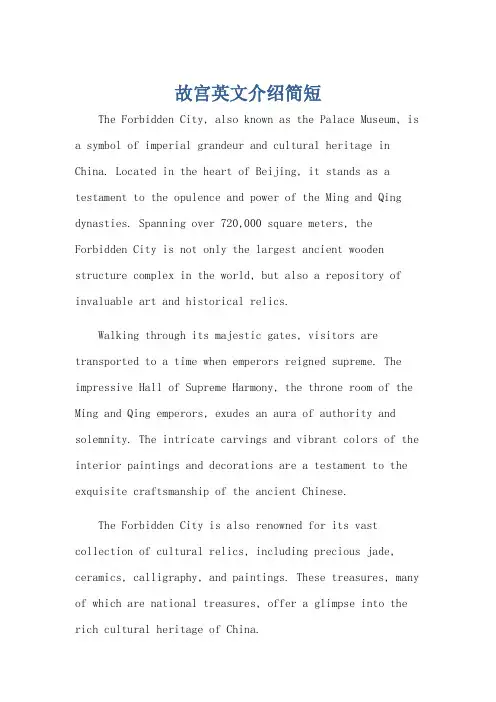
故宫英文介绍简短The Forbidden City, also known as the Palace Museum, is a symbol of imperial grandeur and cultural heritage in China. Located in the heart of Beijing, it stands as a testament to the opulence and power of the Ming and Qing dynasties. Spanning over 720,000 square meters, the Forbidden City is not only the largest ancient wooden structure complex in the world, but also a repository of invaluable art and historical relics.Walking through its majestic gates, visitors are transported to a time when emperors reigned supreme. The impressive Hall of Supreme Harmony, the throne room of the Ming and Qing emperors, exudes an aura of authority and solemnity. The intricate carvings and vibrant colors of the interior paintings and decorations are a testament to the exquisite craftsmanship of the ancient Chinese.The Forbidden City is also renowned for its vast collection of cultural relics, including precious jade, ceramics, calligraphy, and paintings. These treasures, many of which are national treasures, offer a glimpse into the rich cultural heritage of China.Moreover, the Forbidden City serves as an important educational and research center, attracting scholars and tourists alike. Its preservation and restoration efforts have been commended worldwide, ensuring that this magnificent complex remains a vibrant and living part of China's historical and cultural landscape.In conclusion, the Forbidden City is not only ahistorical monument but also a symbol of China's proud past and vibrant present. Its grandeur and beauty continue to inspire and awe visitors from all corners of the world.**故宫英文介绍简短**故宫,又称紫禁城,是中国皇权的象征与文化遗产的瑰宝。
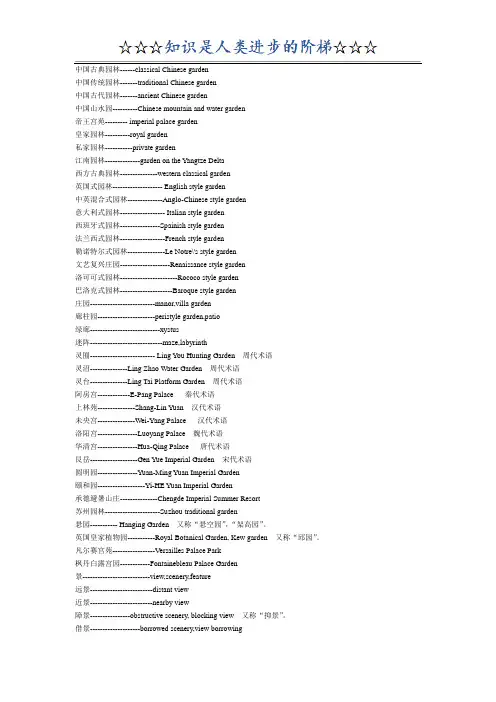
中国古典园林------classical Chinese garden中国传统园林-------traditional Chinese garden中国古代园林-------ancient Chinese garden中国山水园----------Chinese mountain and water garden帝王宫苑--------- imperial palace garden皇家园林----------royal garden私家园林-----------private garden江南园林--------------garden on the Yangtze Delta西方古典园林---------------western classical garden英国式园林-------------------- English style garden中英混合式园林--------------Anglo-Chinese style garden意大利式园林------------------ Italian style garden西班牙式园林----------------Spainish style garden法兰西式园林------------------French style garden勒诺特尔式园林---------------Le Notre\'s style garden文艺复兴庄园--------------------Renaissance style garden洛可可式园林-----------------------Rococo style garden巴洛克式园林---------------------Baroque style garden庄园--------------------------manor,villa garden廊柱园-----------------------peristyle garden,patio绿廊----------------------------xystus迷阵-----------------------------maze,labyrinth灵囿-------------------------- Ling You Hunting Garden 周代术语灵沼---------------Ling Zhao Water Garden 周代术语灵台---------------Ling Tai Platform Garden 周代术语阿房宫-------------E-Pang Palace 秦代术语上林苑---------------Shang-Lin Yuan 汉代术语未央宫---------------Wei-Yang Palace 汉代术语洛阳宫----------------Luoyang Palace 魏代术语华清宫----------------Hua-Qing Palace 唐代术语艮岳-------------------Gen Yue Imperial Garden 宋代术语圆明园----------------Yuan-Ming Yuan Imperial Garden颐和园-------------------Yi-HE Yuan Imperial Garden承德避暑山庄---------------Chengde Imperial Summer Resort苏州园林----------------------Suzhou traditional garden悬园----------- Hanging Garden 又称“悬空园”,“架高园”。
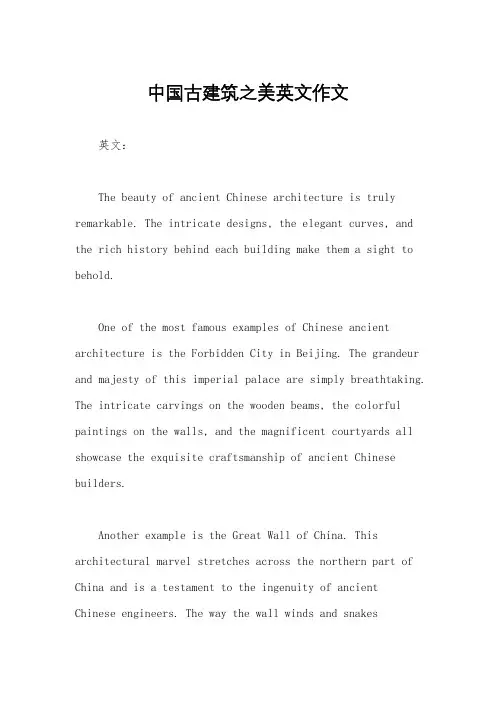
中国古建筑之美英文作文英文:The beauty of ancient Chinese architecture is truly remarkable. The intricate designs, the elegant curves, and the rich history behind each building make them a sight to behold.One of the most famous examples of Chinese ancient architecture is the Forbidden City in Beijing. The grandeur and majesty of this imperial palace are simply breathtaking. The intricate carvings on the wooden beams, the colorful paintings on the walls, and the magnificent courtyards all showcase the exquisite craftsmanship of ancient Chinese builders.Another example is the Great Wall of China. This architectural marvel stretches across the northern part of China and is a testament to the ingenuity of ancient Chinese engineers. The way the wall winds and snakesthrough the rugged terrain is a feat of engineering thatstill astounds visitors today.In addition to these famous landmarks, there are countless traditional Chinese houses, temples, and gardens that also showcase the beauty of ancient Chinese architecture. The elegant curved roofs, the intricatelattice windows, and the serene courtyards all reflect the harmony and balance that are central to Chinesearchitectural principles.The use of traditional materials such as wood, stone, and clay, as well as the incorporation of natural elements like water and plants, further enhance the beauty ofancient Chinese architecture. The attention to detail and the emphasis on harmony with nature make these buildingsnot only aesthetically pleasing but also deeply meaningful.中文:中国古建筑之美确实令人叹为观止。
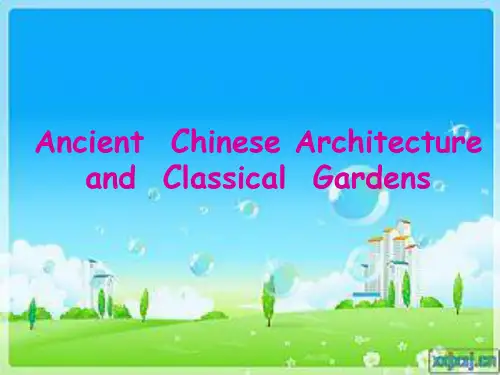
英文作文介绍滕王阁Tengwang Pavilion, also known as Tengwang Ge, is a famous ancient building in China. It is located in Nanchang, Jiangxi Province. The pavilion has a long history and rich cultural connotations.滕王阁,也被称为滕王阁,是中国一座著名的古建筑。
它位于江西省南昌市。
该阁有悠久的历史和丰富的文化内涵。
The pavilion was initially built in the Tang Dynasty, and its construction was completed in 656 AD. It has undergone several reconstructions and renovations over the centuries. The existing pavilion was rebuilt in 1989, presenting the authentic Tang architectural style.该阁最初建于唐代,修建工程于公元656年完成。
在历经数个世纪的重建和翻修之后,现存的阁楼于1989年重新修建,展现出真实的唐代建筑风格。
Tengwang Pavilion is not only a beautiful architectural marvel but also a symbol of the cultural heritage of the region. It has been widely celebrated in Chinese literature, art, and folklore.滕王阁不仅是一座美丽的建筑奇观,而且是该地区文化遗产的象征。
中国著名建筑的英文翻译中国拥有悠久的历史和文化遗产,其中包括许多著名的建筑。
这些建筑在世界范围内享有盛誉,吸引了无数游客和学者前来探索和欣赏。
为了向全世界传播中国的建筑文化,我们需要对这些著名建筑进行准确的英文翻译。
以下是一些中国著名建筑的英文翻译介绍。
故宫故宫是位于中国北京市中心的一座庞大古建筑群,始建于明代,后成为清代中国皇室的主要居所。
故宫作为中国古代宫廷建筑和古代祭祀体系的杰出代表,以其独特的建筑风格和丰富的历史价值而闻名于世。
英文翻译:The Palace Museum长城长城是中国古代修建的一系列军事防御工事,起源于春秋时期,最著名的部分位于河北省。
长城是中国历史上最重要的建筑工程之一,也是世界文化遗产的代表之一。
长城被誉为人类历史上最伟大的工程之一,从古代起就是中国国家的象征。
英文翻译:The Great Wall兵马俑兵马俑是位于中国陕西省西安市的秦始皇陵附近的一座巨大的陪葬坑,被誉为世界八大奇迹之一。
这些陶制的兵马俑是中国古代帝王陵墓中的守卫者和护卫者,规模宏大、栩栩如生的兵马俑形象震撼人心,对于了解中国古代军事、文化和艺术都具有重要意义。
英文翻译:The Terracotta Army天坛天坛是位于中国北京市的一座古代祭祀建筑群,始建于明代。
天坛是古代中国皇帝举行祭天仪式的地方,被誉为中国古代祭祀建筑的杰出代表,同时也是世界文化遗产之一。
天坛的设计和建筑风格凝聚了中国古代哲学和天文学的智慧。
英文翻译:The Temple of Heaven颐和园颐和园是位于中国北京市郊区的一座庭院建筑群,始建于清代。
颐和园是中国古代皇家园林的杰作,被誉为中国园林艺术的典范,也是世界文化遗产之一。
颐和园集娱乐、游览、宴会等多功能于一体,以其宏伟的建筑和精美的园林景观而闻名于世。
英文翻译:The Summer Palace以上是对中国一些著名建筑的英文翻译介绍。
这些建筑是中国古代文化的重要组成部分,它们通过其独特的建筑风格和丰富的历史背景,极大地吸引了国内外游客的关注。
中国古建筑之美英文作文The beauty of ancient Chinese architecture is truly mesmerizing. The intricate designs and attention to detail are simply breathtaking. Walking through these ancient buildings, one can't help but feel a sense of awe and wonder at the craftsmanship of the past.The traditional Chinese architecture is a reflection of the rich cultural heritage of the country. The use of wood, stone, and other natural materials creates a harmonious and peaceful atmosphere. It's like stepping into a different world, where time stands still and the beauty of the past is preserved for all to see.The unique roof designs of ancient Chinese buildings are one of the most striking features. The sweeping curves and intricate carvings are a testament to the skill and artistry of the craftsmen. Each roof tile is placed with precision, creating a seamless and elegant look that is truly one of a kind.The use of symbolism in ancient Chinese architecture is also fascinating. From the placement of certain elements to the use of colors and patterns, every detail has a deeper meaning. It's like a language of its own, telling stories and conveying beliefs through the design of the buildings.The sense of harmony and balance in ancient Chinese architecture is truly remarkable. The careful placement of buildings, courtyards, and gardens creates a sense of tranquility and peace. It's a reminder of the importance of living in harmony with nature and the world around us.In conclusion, the beauty of ancient Chinese architecture is something that must be experienced firsthand. It's a journey through time and culture, a glimpse into the rich history and traditions of the Chinese people. The intricate designs, symbolism, and sense of harmony all come together to create something truly extraordinary.。
故宫英文作文故宫位于中心。
中国现存最大、最完整的古建筑群。
被誉为之一。
下面是小编整理的关于故宫英文,欢迎阅读参考。
故宫英文作文【1】The Palace Museum is located on city center in Peking.China is existing biggest, most integrity of thou building cluster.It is been one of five greatest temples in the world by the fame.The Palace Museum start to set up in A.D.1406, the Palace Museum have the size courtyard more than 90s and the house contain 980 and add up to 8704.the Palace Museum surroundings surround 12 meters in height, long the Palace Museum wall of 3400 meters, form is one rectangular city defense, there is 52 meter wide moat outside the wall surround, formation a fortress of severe barracks.The Palace Museum has 4 doors, center door Wu door, east door Donghua door, west door Xihua door, north door Shengwu door.故宫英文作文【2】(In front of the meridian gate)Ladies and Gentlemen:I am pleased to serve as your guide today。
故宫英文作文故宫英文作文故宫位于中心。
中国现存最大、最完整的古建筑群。
被誉为之一。
下面是小编整理的关于故宫英文,欢迎阅读参考。
故宫英文作文【1】The Palace Museum is located on city center in Peking.China is existing biggest, most integrity of thou building cluster.It is been one of five greatest temples in the world by the fame.The Palace Museum start to set up in A.D.1406, the Palace Museum have the size courtyard more than 90s and the house contain 980 and add up to 8704.the Palace Museum surroundings surround 12 meters in height, long the Palace Museum wall of 3400 meters, form is one rectangular city defense, there is 52 meter wide moat outside the wall surround, formation a fortress of severe barracks.The Palace Museum has 4 doors, center door Wu door, east door Donghua door, west door Xihua door, north door Shengwu door.故宫英文作文【2】(In front of the meridian gate)Ladies and Gentlemen:I am pleased to serve as your guide today。
干栏式房屋(gān lán shìfáng wū)Stilt HouseBuilding a home above land or waterStilt houses, or ganlanshi fangwu in Chinese, are dwellings built on piles and raised over thesurface of either land or water.They appear mostly in areas south of the Yangtze River and the southwest regions of the country,which have wet climates and frequent flooding.The houses are earthquake resistant due to their light structure and they are also easy to buildbecause they don't need a lot of ground leveling work like other buildings.According to archeological discoveries from the Yuyao Hemudu Heritage Site of ZhejiangProvince, as well as those from other historical sites around the country, Chinese people began tobuild stilt houses some 6,000 to 7,000 years ago. The Hemudu people, who are said to be the first to cultivate rice, lived in long, stilt houses and historians believe their Neolithic culture was greatly affected by two major floods. People inthese areas have inherited this ancient architectural technique and have developed a variety ofstilt houses due to their local living conditions and environment.The stilt house built by the Hemudu peopleOn Hainan Island, the Li ethnic people build stilt houses resembling overturned boats. Theyfeature thatched roofshanging down to the ground. It is said that such stilt houses hold upbetter during typhoons.Most stilt houses are usually erected on piles 20 to 30 centimeters in diameter and are made oftimber and bamboo. The timber is used mainly for the house frames and bamboo is used tomake beams, rafters, floors, walls, stairs and railings. All building parts are joined by tenon andmortise works or flat bamboo strips.Such houses often have a thatched roof, but some use tiles to protect against strong winds.Stilt houses are usually built on riversides or along gentle mountain slopes. Space underneath isgenerally used for storage or to raise chickens, ducks, pigs, sheep, rabbits and, if the gap is bigenough, cattle.Most stilt houses are two-story structures but in some areas there are three-story versions.Under the influence of Buddhism and the Han people's architectural styles in northern China, thecentral room on the second floor is invariably used as a sitting room with a shrine and a fire pit.Families eat their meals and share time together around the fire pit. The rooms on either side orbehind areoften used as bedrooms.Some stilt houses are stand-alone dwellings while others are joined by long verandas or bridges.In many areas where ethnic minorities live in southwest China, stilt houses are still widely usedtoday. But some have become tourist attractions and others have even been turned into hostelsto accommodate tourists.For example, Fenghuang Ancient Town in Xiangxi Tujia and Miao Minorities Autonomous Regionin western Hunan Province features beautiful stilt houses along the Tuojiang River. They attractmillions of visitors very year.Pictorial dictionary·侗族鼓楼(dòng zúgǔlóu) drum towers of the Dong peopleGulou, or drum towers, were built in the center of cities to either send out warnings of pendinginvasions or to mark the hour.But the drum towers of the Dong people, an ethnic group living in southern and southwesternChina, have their unique features.The stilted structure, which could reach more than 20 stories high, served as a place of gathering.They were equipped with a long drum, and whenever there were important events, the villagehead would beat the drum to assemble the villagers.Dong drum towers are built purely of timber and appeared in different shapes such as square,hexagon or octagon. They are often richly decorated with wood carvings, clay figurines andcolorful paintings.A drum tower is part and parcel of a Dong village even in nowadays. Villagers often gather in thetower to sing, dance and socialize.。